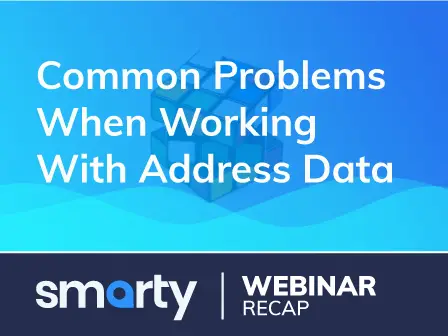
There are many problems you may run into if you're working with address data. In our recent webinar, our own Adam Charlton went over some of the challenges he's encountered the most, and how to deal with them.
Here’s some of what he talked about. You can view the full recording at the link below.
Standardization
Standardizing addresses helps solve many of the problems inherent with data blending (combining two or more address databases together). In order to properly blend different address databases together you need to either have an external ID correlate the two sources, or have identically formatted address fields.
It’s worth noting that the USPS DPV barcode is not sufficient for data blending. It can be very difficult to properly correlate addresses going off ove the DPV barcode only. See “Semi-valid Addresses” below for more information on that.
Human Error
Human error is a natural occurrence, but can wreak havoc on an address database. If you decide that you’re going to self-standardize your database and change every “street”, “avenue”, or “boulevard” to a standard abbreviation, there’s plenty of opportunity to make mistakes.
Imagine what would happen if you have a correct address but it is not standardized, and when trying to manually standardize it you accidentally change a number. The issues just pop up from there.
The solution is using an automated system to standardize your address database. This could be through a bulk standardizing tool, an API, or other means.
An additional benefit to using an external standardizing tool is that it will likely also validate the addresses. Standardizing means to make an address appear correctly, but validating means that it is an actual mailable address. So what should be considered when validating an address database?
Common Address Validation Issues
Not every address validation tool is created equal. Many will merely tell you if it’s mailable or not, but even those who’t tell you why they're not mailable.
Adam went over three main problems that most people run into when trying to validate addresses.
Unique ZIP Codes
There are some places in the United States that receive such a high volume of mail that the USPS has given them their own ZIP Code. For example, the Empire State Building, some university campuses, or other large corporate offices.
This means that when you use a validation service that uses the USPS database, you won’t get a whole lot of information about those addresses because as long as it has those ZIP Codes, it is mailable, but still might not get where it needs to go.
There’s a lot more information about this in one of Adam’s previous webinars, Address Data Masterclass.
Smarty counteracts this challenge by ensuring that we are informing the user of ,unique ZIP Codes, and we have three unique places to make sure you’re informed.
Semi-valid Addresses
Addresses that are missing secondary addresses may still be valid, but may not get your mail delivered to them. This means if you mail something to da large apartment building, but you put an apartment number that isn’t in the building, it would still be identified as mailable. However, Smarty’s validation tools will ensure that you are aware that your address may have trouble delivering to that address.
R7 addresses fall into this category. These are mailable, but they are not street-deliverable. This sort of mail is typically picked up from the post office, and does not have a DPV barcode.
Non-Postals
Not every address is USPS-serviceable. This does not mean that these addresses are not real, though. Depending on your use-case, these addresses may still be valid. For example, if you’re trying to mass-mail something to addresses that are non-postal, they are probably not valid. But if you’re a real-estate developer they may be valid for your purposes.
Typically to validate non-postal addresses you’ll need a special validation service. Smarty has an Enhanced Match validation tool that handles these like a dream.
Watch the Full Recording
If you’d like to view the full 36 minute webinar, feel free!

 Sawyer Hendrickson
Sawyer Hendrickson John Hickey
John Hickey